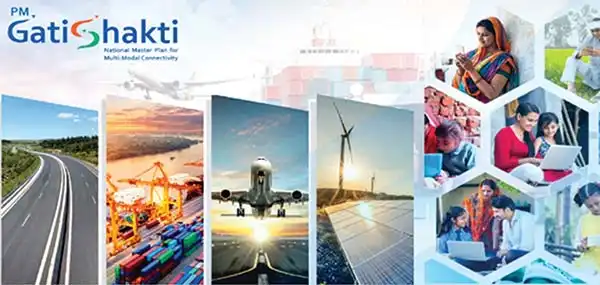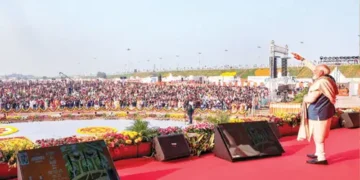Blitz Bureau
P M Gati Shakti’, the national master plan for multi-modal connectivity, celebrated its third anniversary on October 13 this year. This digital platform is designed to bring various ministries to ensure integrated planning and coordinated execution of infrastructure projects. The initiative aims to provide seamless and efficient connectivity for the movement of people, goods, and services across various modes of transport.
The programme incorporates infrastructure schemes of various ministries and state governments such as Bharatmala, Sagarmala, inland waterways, dry/land ports, and UDAN. The PM Gati Shakti national master plan (NMP) has onboarded 44 Central ministries and 36 states/UTs and a total of 1,614 data layers have also been integrated. To ensure data accuracy, key infrastructure ministries have finalised SOPs for a three-tier system. A compendium on PM Gati Shakti NMP on data management, prepared by DPIIT, outlines the stakeholder responsibilities.
Compendium developed
The compendium Volume I and Volume II has been developed and launched, that highlights the success stories of PM Gati Shakti. A milestone of assessing 208 big-ticket infrastructure projects worth Rs 15.39 lakh crore has been achieved. Additionally, 434 projects under three economic corridors of the Ministry of Railways have been evaluated and shared with the PMO. They are Energy, Mineral, and Cement Corridors, High Traffic Density Corridors and Rail Sagar.
A district master plan (DMP) portal is being developed to extend PM Gati Shakti to the district level. This portal will aid district authorities in collaborative planning, infrastructure gap identification, and scheme implementation. A beta version of this portal has been created and trial runs of the portal are ongoing. The DMP portals for all districts in the country will be developed in a phased manner and completed by March 31 next year.
Key accomplishments
The PM GatiShakti NMP has resulted in numerous achievements across various sectors, significantly improving project planning, speed, and execution. The Ministry of Road Transport and Highways planned over 8,891 km of roads using NMP, while the Ministry of Railways used NMP to plan more than 27,000 km of railway lines.
The Ministry of Petroleum and Natural Gas streamlined the process for Detail Route Survey (DRS), reducing the time required to create reports from six-nine months to just one day using electronic DRS.
Using NMP principles, a 13 GW renewable energy project from Leh to Kaithal in Haryana) achieved optimal alignment of the ‘Green Energy Corridor’. Goa used the NMP platform to develop a disaster management plan for flood-prone areas. The UP Government employed the state master plan portal to identify locations for new schools in underserved areas.
Gujarat planned
its 300 km coastal corridor using NMP, which reduced the number of NoC permissions required for clearance from 28 to 13. The Department of School Education and Literacy used the NMP portal to link PM Shri Schools with local industries for district-specific skill training. The Ministry of Health and Family Welfare identified internet shadow areas and mapped sites for new healthcare facilities.
NLP key initiatives
The National Logistics Policy (NLP) was launched on September 17, 2022 to boost economic growth by creating an integrated, efficient, and cost-effective logistics network. The policy aims to reduce logistics costs, improve Logistics Performance Index (LPI) ranking to be among the top 25 countries by 2030, and promote data-driven decision-making. Implementation is driven by the Comprehensive Logistics Action Plan (CLAP), focusing on areas such as digital logistics systems, asset standardisation, human resource development, state engagement, and EXIM logistics.
The policy emphasises training and capacity-building efforts in collaboration with the Capacity Building Commission (CBC). Training modules are integrated with Central and administrative training institutes through webinars, workshops, and digital platforms. State Logistics Plans: Twenty-six states and UTs have aligned with the National Logistics Policy by notifying their state logistics policies to enhance focus on logistics in public policy.
LEADS Survey: The fifth edition of the Logistics Ease Across Different States (LEADS) report was launched in December 2023, with the sixth edition released in January 2024. LEADS assesses logistics ease based on infrastructure and services across States and UTs.
Unified Logistics Integrated Platform: It integrates 33 logistics-related systems across 10 ministries, promoting innovation. Currently, over 930 private companies are registered, with 95 applications made live and 185 companies signing NDAs. Logistics Data Bank: For tracking and tracing 100 per cent of containerised EXIM cargo, the Logistics Data Bank (LDB), has been developed. LDB uses RFID technology through the Internet of Things (IoT), Big Data and Cloud-based solutions to provide real-time tracking of EXIM container movement in India.
Improving LPI rank
A dedicated LPI Action Plan has been created, involving multiple ministries to address logistics challenges across six LPI parameters. Continuous engagement with the World Bank has resulted in discussions on logistics efficiency, reforms, and LPI methodology, along with a national workshop held in February 2024. The policy incorporates global best practices, collaborating with the Asian Development Bank and Korea’s LPI improvement strategies. A round table with the World Bank was held in the US in March 2024 to discuss innovative approaches and logistics improvements for India. Through these efforts, NLP is driving India towards a more efficient logistics ecosystem while enhancing global competitiveness.
Gati Shakti portal
The Gati Shakti Sanchar portal is a major reform brought in to facilitate faster rollout of telecom infrastructure. It is a Centralised Right of Way (RoW) Portal that enables applicants such as telecom service providers/infrastructure providers/ internet service providers to apply for RoW approvals. As on October 11, 2024, 2.11 lakh applications have been approved. The portal is integrated with all 36 states /UTs and with relevant Central ministries.
The PM Gati Shakti initiative represents a transformative approach to infrastructure development in India, aiming to create a seamless and efficient multimodal transportation network. By integrating the efforts of various ministries and leveraging advanced technologies, thes initiative seeks to enhance connectivity and reduce logistics costs across the nation.






























